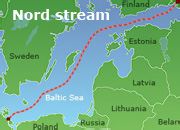The celebrations were attended by Alexey Miller, Chairman of the Gazprom Management Committee, heads of the Company's subdivisions and contracting companies.
“We have started building the last facility of the onshore section of the Nord Stream gas pipeline. We will launch construction of the offshore section this spring.
The Portovaya CS will be a unique gas transmission facility in terms of aggregate capacity, working pressure (220 Ata), gas transmission distance and daily gas dehydration volume. The station is unparalleled in the world. This facility is at the forefront of the sci-tech progress in the gas industry. When implementing this project Gazprom will utilize novel equipment and cutting-edge technologies. The station will secure gas transmission over the distance of 1,200 kilometers via the Nord Stream and no extra compressor stations will be built on the German coast.
The CS construction is a crucial stage in Gazprom’s activities aimed at diversifying the Russian gas supply routes and enhancing the European energy security,” stated Alexey Miller.
The first-stage compressor capacities at the Portovaya CS are projected to be put onstream in 2011, with the subsequent increase up to 366 MW by late 2012.
At present, the Russian Federation doesn’t produce technologies or equipment that will be utilized during the CS construction.
The Portovaya CS will comprise 6 gas-pumping units (GPU) with the capacity of 52 MW and 2 GPU with the capacity of 27 MW. The 52 MW units will be utilized for the first time in the operation history of the Russian Unified Gas Supply System.
The gas treatment unit (GTU) of the Portovaya CS will not permit condensate or gas hydrates in the submerged gas pipeline, thus raising the technical reliability of the Nord Stream.
The GTU construction project is unique, as it envisages making a world’s unparalleled unit in terms of performance rates. The unit is designed to dehydrate 120 million cubic meters of natural gas daily, which is 3.6-fold higher compared to the GTU of the Krasnodarskaya CS at the Blue Stream gas pipeline running across the Black Sea bottom from Russia to Turkey. The first phase of the GTU is to be installed by late 2010, the second – by late 2011.
The Gryazovets – Vyborg gas trunkline (length – 900 kilometers, annual design capacity – 55 billion cubic meters) is intended for securing gas deliveries from the Unified Gas Supply System to the Nord Stream gas pipeline and supplying consumers of Russia's Northwestern region. The gas pipeline will cross the Vologda and Leningrad Oblasts. By now, over 600 kilometers of the pipeline have been built. The linear part is to be completed by late 2010.
Construction of the Gryazovets – Vyborg gas pipeline is synchronized with the actions on the Nord Stream project and fulfilled according to the approved schedule. The pipeline will be put onstream in a stagewise manner starting from 2011. The design capacity is projected to be achieved by late 2012.
The advanced practices of domestic companies and innovative technical solutions are utilized during the construction, thus ensuring high reliability, technical and economic efficiency and environmental safety.
The domestically-manufactured pipes and check valves of the new generation are used for the linear part of the pipeline.
The pipeline crossing through watercourses are being built using the horizontal directional drilling and microtunneling techniques, which makes it possible to avoid interference into river ecosystems during the construction and operation processes.
In the aim of raising the energy efficiency of gas transmission during CS building, a new-generation energy-saving equipment with increased efficiency is provided for.
The Nord Stream gas pipeline is a fundamentally new route of Russian gas export to Europe. The gas pipeline will cross the Baltic Sea from the Portovaya Bay (near Vyborg) to the German coast (near Greifswald). The gas pipeline will stretch some 1,200 kilometers. This way, the Nord Stream will directly link the Russian Unified Gas Supply System with the gas transmission system of the European Union.
The Nord Stream is being implemented in strict compliance with the existing schedule. Permits have been granted to construct the submerged gas pipeline by all the so-called transit countries – Denmark, Germany, Russia, Finland and Sweden. The first string of the Nord Stream is to be commissioned in 211, the second – in 2012. The annual aggregate capacity of the gas pipeline will make up 55 billion cubic meters.
24 Декабря 2025 | среда | 21:32


